CHRONOLOGY
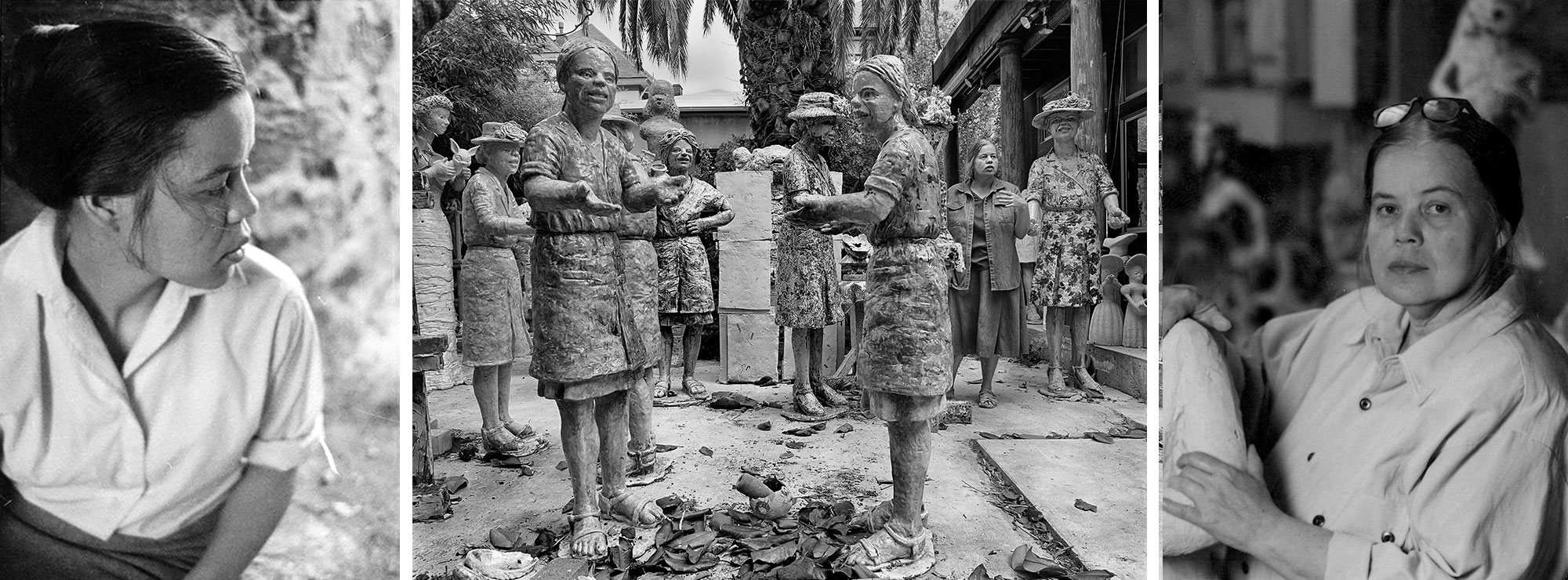
left to right: Viola Frey, c. 1958. Photo: Jeff Schlanger; View of the Oakland Avenue backyard, 1980. Photo: Kurt Edward Fishback; Viola Frey, c. 1990-91.
For a complete chronology with citations, check out the new book Viola Frey: Artist’s Mind/Studio World or request a PDF.
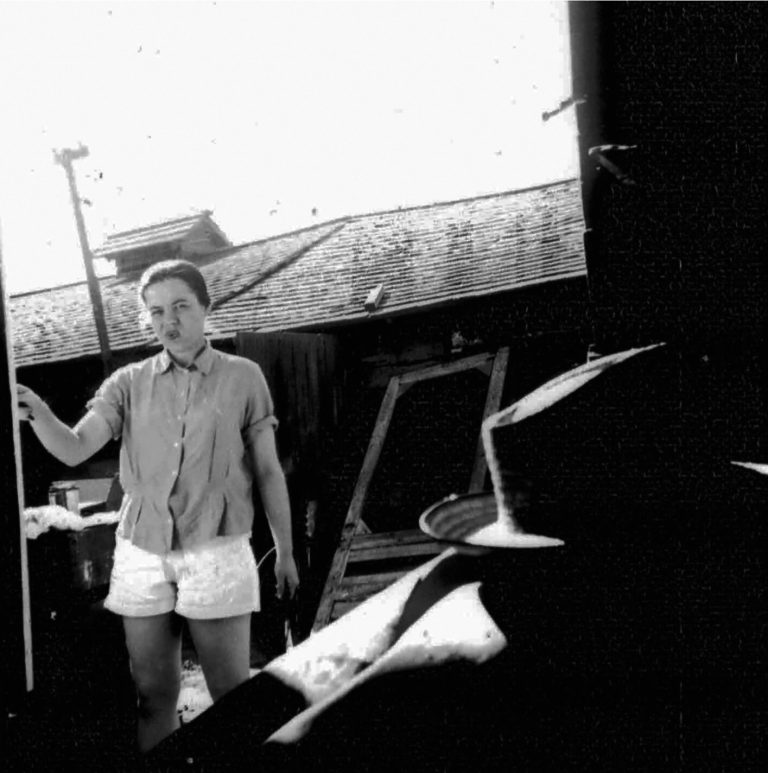
Viola Frey at the family farm, Lodi, CA, 1949
1933–50
Viola Frey is born on August 15, 1933—near the height of the Great Depression—in Lodi, California. She is the second of four children and grows up on a grape farm.
1951–54
Frey graduates from Lodi High School in 1951 and enrolls at nearby Stockton Delta College (SDC, now San Joaquin Delta College) with an interest in writing, but later shifts her focus to teaching art at the college level. After two years at SDC, Frey transfers to the California College of Arts and Crafts (CCAC, now California College of the Arts) and moves to Oakland.
1955–59
Frey takes painting classes with painter Richard Diebenkorn. At the end of the spring semester in 1956, she receives her undergraduate degree from CCAC. With the encouragement of ceramic instructors Vernon Coykendall and Charles Fiske, she applies and is accepted to the graduate fine arts program at Newcomb College at Tulane University (now Newcomb-Tulane College), New Orleans.
While there, Frey studies ceramics with Katherine Choy and painting with Mark Rothko, who is a visiting artist-in-residence at Tulane. Frey would later cite him as a major influence on her study and use of color.
Just before completing her graduate degree, Frey moves with Katherine Choy to Port Chester, New York, who has founded the Clay Art Center. Its purpose is to advance the study of ceramics and sculpture through the promotion of the art of clay and to encourage clay artists to develop their own work. During her time in New York, Frey noted several artists’ influence, including the Art Brut work of Jean Dubuffet, Pablo Picasso’s ceramics, and the first figurative painting show by Richard Diebenkorn.
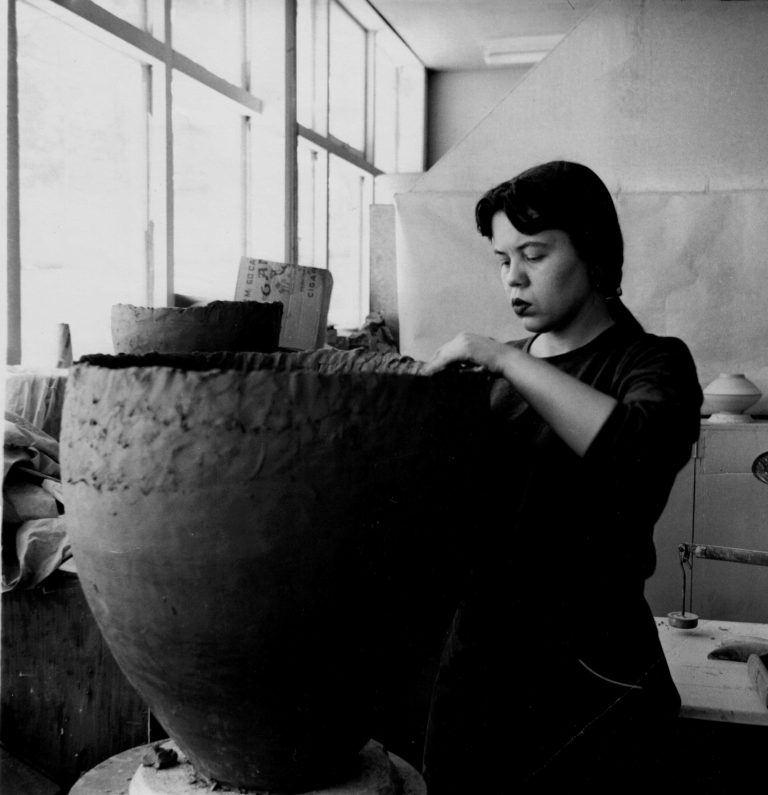
Viola Frey at CCAC, Oakland, CA, c. 1954
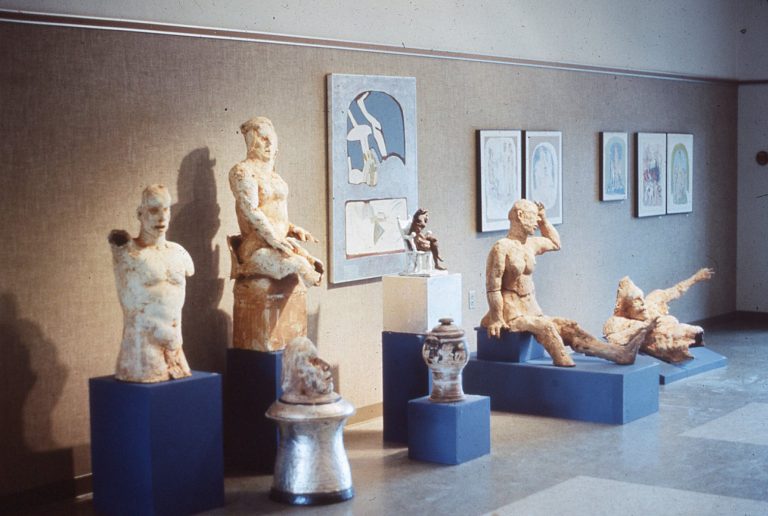
Trophies in Clay by Viola Frey at Chabot College Art Gallery, Hayward, CA, 1969
1960
Frey moves to San Francisco, citing several reasons for her return to California: the mild climate, which spared her from having to purchase “two wardrobes”; Charles Fiske’s return to the Bay Area; and a growing interest among West Coast artists in the figure as subject and in clay as a medium for art.
1965
Frey purchases a fixer-upper Victorian house at 1335 Divisadero in San Francisco. Charles Fiske moves in with her around this time and will remain Frey’s companion until his death.
1969
Frey’s solo exhibition Trophies in Clay, at Chabot College Art Gallery, Hayward, California, includes figurative sculpture, sgraffito drawings, and sculpture and paintings with silver leaf.
1970
Frey begins to make works about the Alameda Flea Market, which for her is a place for cultural observation and study. She first creates sketches and drawings and later documents the scenes of people and “all the trifles that fill the cottages of thousands of people, things briefly cherished” in slide photographs she takes during her visits. Around this time, Frey starts collecting figurines.
1971
With the first floor of her Divisadero house now crowded with finished work, Frey holds a weekend sale of paintings, drawings, and clay objects. The sale provides enough money to transform the basement into a “real studio.”
Frey becomes a full-time assistant professor in the ceramics department at CCAC, working alongside Coykendall and Art Nelson.
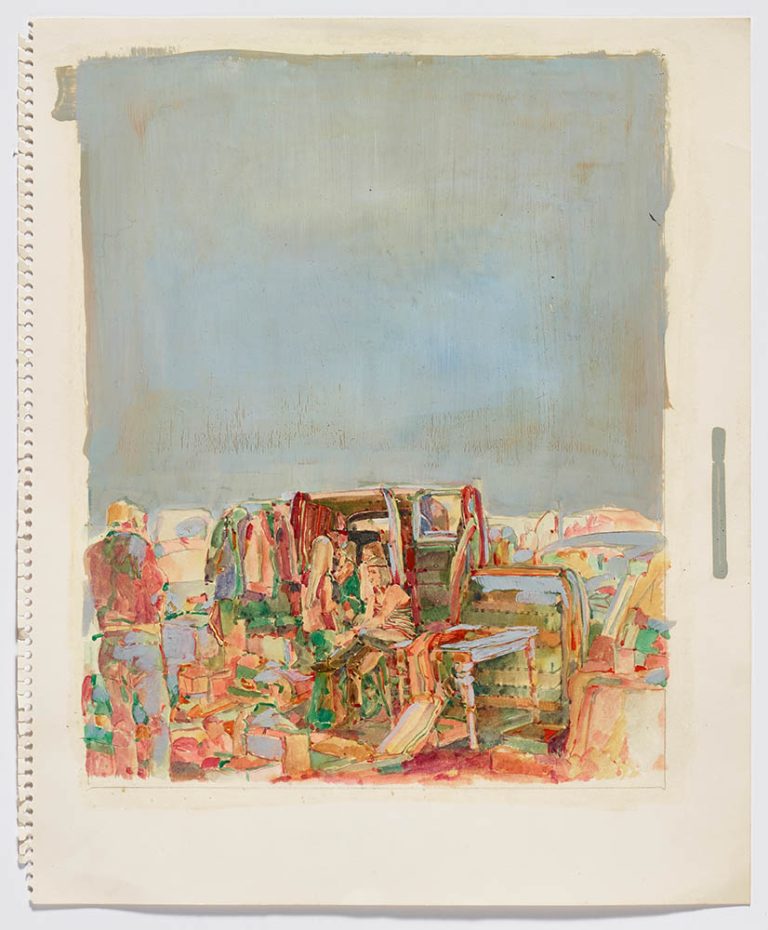
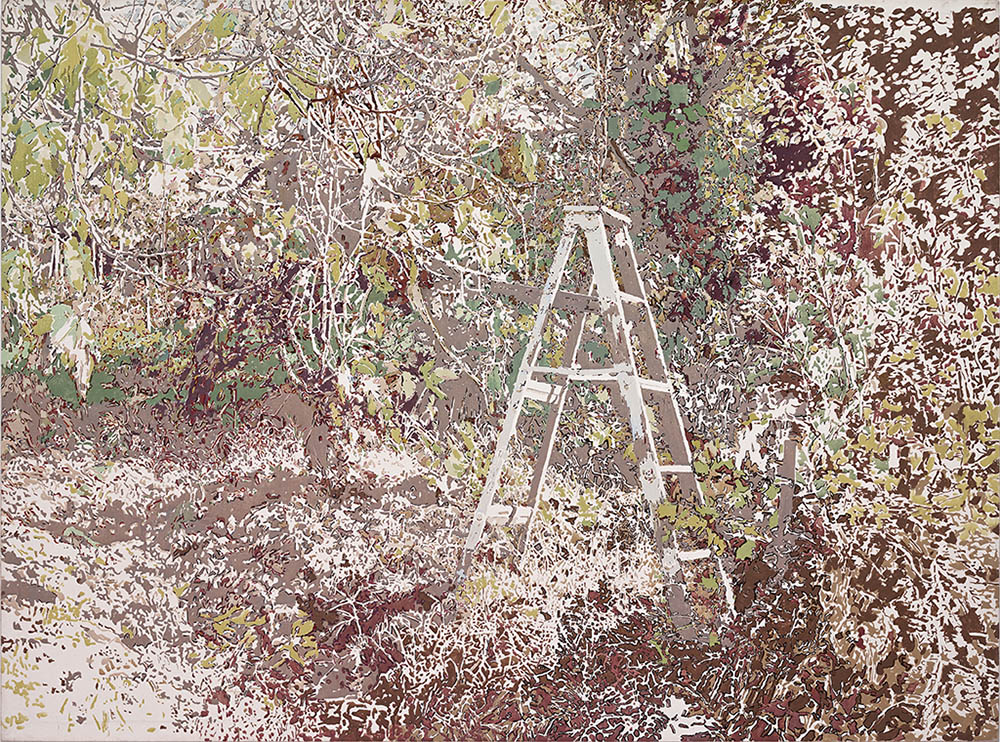
Viola Frey, Father’s Farm, 1975, oil and acrylic on canvas,
58 x 78 inches (147.3 x 198.1 cm), VF-0155PT
1973
Frey, Coykendall, and Nelson steer the design and construction of CCAC’s Noni Eccles Treadwell Ceramic Arts Center (a.k.a. the Pot Shop), which expands the ceramics program and doubles student capacity.
The death of Frey’s father in November prompts her to document the family farm through a series of photographic slides of “vineyards, the garages, sheds filled with junk, the trees, the things old Mr. Frey had cherished,” a project that marks a shift in Frey’s visual language.
1975
The continued decline of their San Francisco neighborhood prompts Frey and Fiske to move to Oakland. Frey purchases a home at 663 Oakland Avenue, Oakland. She sets up a painting and drawing studio on the first floor and oversees the construction of a ceramic studio in the backyard. While the ceramic studio is being built, she photographs using 35mm film her expanding figurine collection in various tableaux.
When her ceramic studio is finished, Frey begins painting larger ceramic sculptures outdoors, where she can more easily study the surface play of light and color. She focuses on building vertically so she can maximize space in the backyard and study the relationships between the sculptures in the changing light.

Viola Frey in the backyard at 663 Oakland Avenue, Oakland, CA, 1980-81
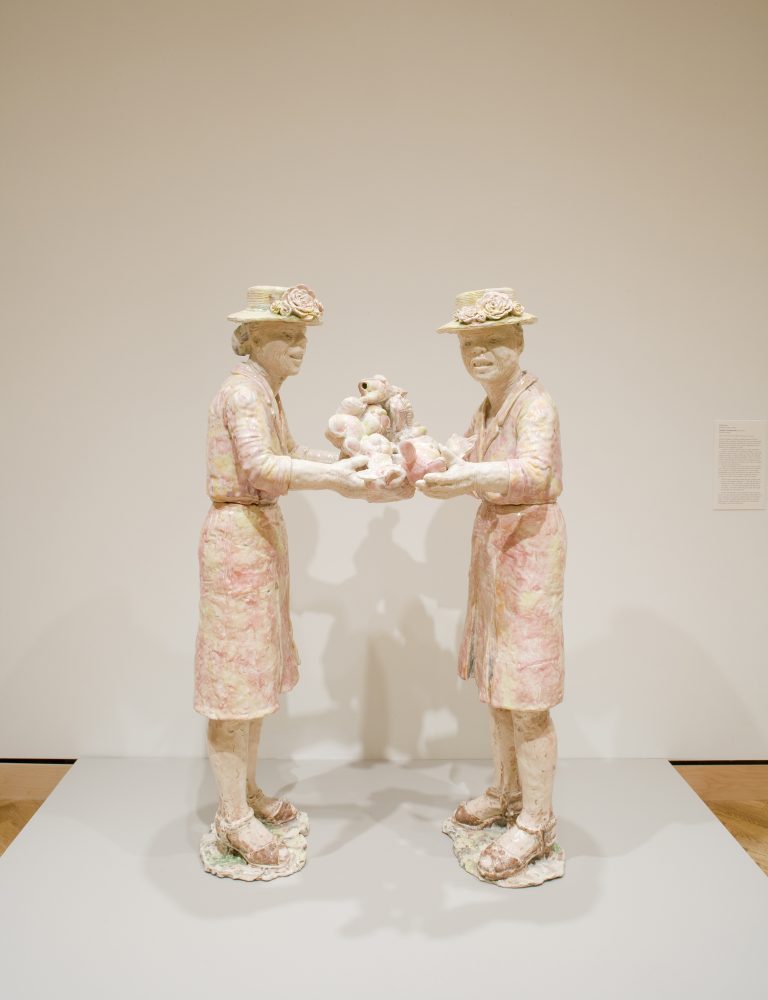
Viola Frey, Double Grandmother, 1978-1979, whiteware, glazes, and china paint, each 62 x 24 x 23 inches (157.5 x 61 x 58.4 cm), VF-3134CS, Collection of Minneapolis Institute of Art, gift of funds from the Regis Corporation
1978
Frey makes her first Grandmother Series sculpture. Viewed as symbols of power, these works are inspired by her paternal grandmother, who ran the farm, and by “growing up around National Geographic. . . . My father never went on vacations, but he always looked at National Geographic. But in that magazine [there] was always that grandmotherly looking figure wearing a hat, gloves, a bag, and these shoes, and a lovely dress. And she’d be standing in the middle of a road in Africa, next to Chieftains, dressed in this way.”
Frey is awarded a $7,500 Craftsmen’s Fellowship Grant from the National Endowment for the Arts (NEA).
1980
Frey joins the Quay Gallery (later Rena Bransten Gallery), located at 254 Sutter Street, San Francisco. Her first show includes paintings and ceramic sculptures, marking the beginnings of her recognition as an interdisciplinary artist.
1981
Frey’s first museum retrospective is organized by the Creative Arts League of Sacramento. It opens at the Crocker Art Museum and travels to six venues around the United States. The first presentation includes more than eighty paintings, works on paper, sculptures, and the Xerox slide tableaux. The exhibition layout was primarily designed by Frey and mimicked arrangements of the work at her Oakland studio/home.
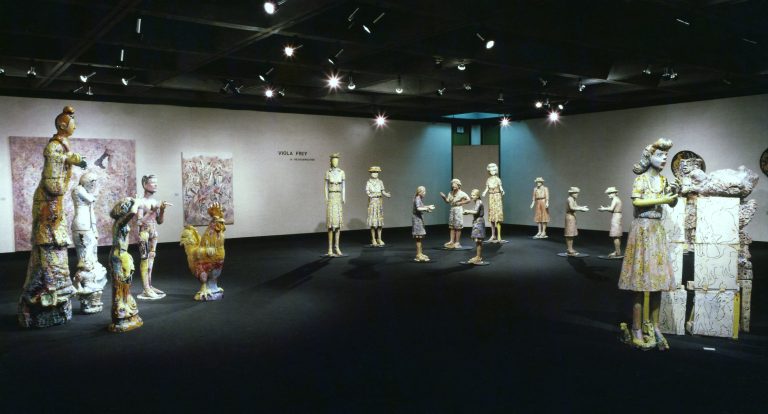
Viola Frey: A Retrospective at Crocker Art Museum, Sacramento, CA, 1981. Photo: M. Lee Fatherree
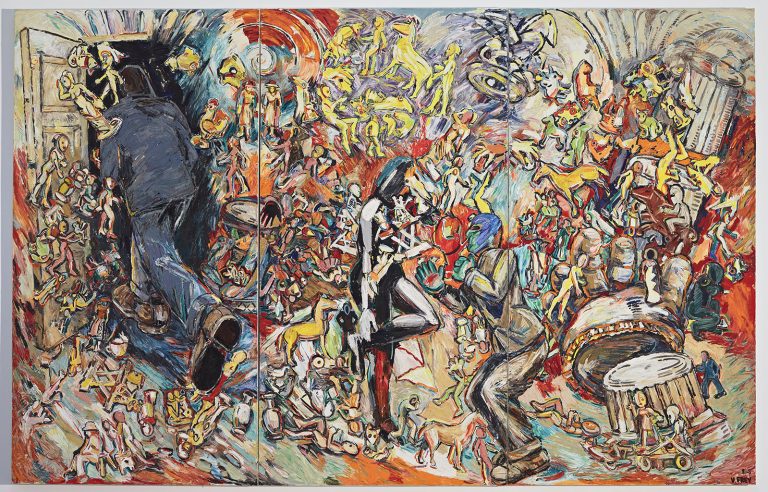
Viola Frey, Studio View: Man in Doorway, 1983, alkyd oil on canvas, 105 1/2 x 165 1/4 inches (268 x 419.7 cm), VF-0089PT
1983
Frey moves her studio to a 5,000-square-foot warehouse at 1089 Third Street in West Oakland because the “backyard was filled to the point of gridlock.” The new, larger space inspires horizontal works, including the reclining nudes and fallen men in suits. “I do like industrial areas in terms of space,” Frey later recalls. “My house in Oakland is probably 30 by 40 feet, with two stories, but the sense of scale is that of an ordinary room; the quality of its space is not sufficient. . . It’s good storage for books, but it’s not the kind of space that sets your mind to knowing. A house is divided into walls and small rooms, whereas this kind of place allows your mind to travel. When you see space in a pure form, it does change your view of the world. . . I always fought against the restrictions of the smaller space. The figures in the home studio were sort of hunching over because they were too close to the ceiling. They were able to evolve into their own size here. . . I don’t want to ever reach the ceiling now, there’s a certain size beyond 11 feet that becomes too colossal, and I’m not interested in that.”
1984
Patterson Sims organizes Frey’s first solo museum exhibition at the Whitney Museum of American Art, New York. Sims highlights the significance of the exhibition in his essay: “Clay has traditionally been associated with craft rather than fine art in America, so that Viola Frey, who works primarily in ceramic, has not received full recognition as a serious sculptor. In fact, clay is but one of the media Frey employs and is only the starting point for her creative concerns. Content, more than refinement of craft, is her ultimate objective.”
Later in the year, a second solo exhibition opens at Moore College of Art, Philadelphia, and travels to two additional venues. This presentation is nearly twice as big as the Whitney’s, and the accompanying catalogue includes Sims’s essay from the Whitney exhibition pamphlet and an interview conducted by Garth Clark.
Frey begins drawing nude models once a week during kiln-firing days as a way “to bring the subject matter” into the empty warehouse studio. During each session she sketches dozens of various poses in graphite and charcoal, and later fills them in, using pastels, with additional imagery drawn from her personal lexicon.
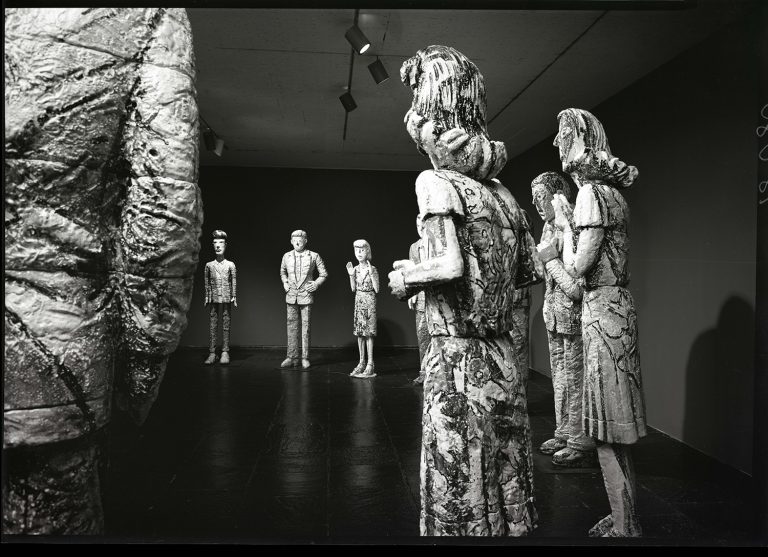
Exhibition view of Viola Frey at Whitney Museum of American Art, New York, NY, 1984. Photo: Whitney Museum of American Art Archives
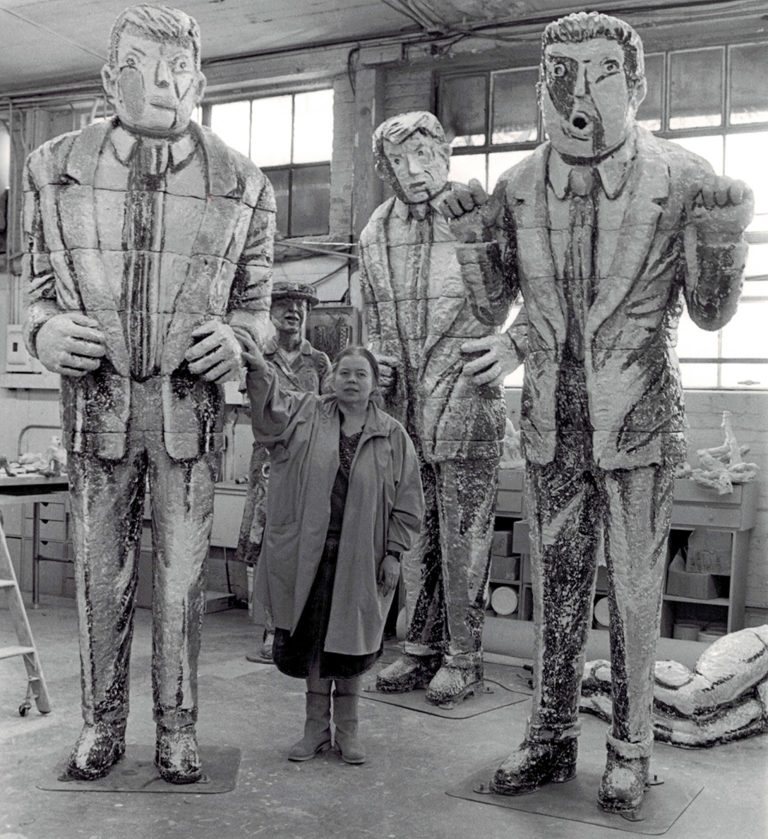
Viola Frey in the studio at 1089 Third Street, Oakland, CA, 1986. Photo: Chris Felver
1985
Frey travels to France for a residency at the Atelier Expérimental de Recherche et de Création, Manufacture nationale de Sèvres. The recently formed artist residency allows Frey to experiment with white porcelain clay in the historic factory. At the end of the residency, Frey leaves behind unfinished work that she will return to complete the following year.
In her Oakland studio, Frey begins a series of reclining male nude figures in response to the HIV/AIDS epidemic. She remarks on the vulnerability she captures in these sculptures: “It just makes man more human. Because no one wants to be a hero all the time.”
1986
Frey’s tallest men in suits—which now are more than ten feet high—are exhibited at Asher/Faure. She later comments: “I don’t ever want to reach the ceiling. . . . [T]here’s a certain size beyond 11 feet that becomes too colossal, and I’m not interested in that.” Instead, she prefers the “heroic, grand—a public size” for her figures.
Frey receives her second NEA award, an Artist Fellowship Grant in Ceramics of $15,000.
1987
Frey returns to Manufacture de Sèvres and works with Betty Woodman and Richard Shaw on several collaborations, in addition to her own projects. The time spent in Sèvres has a lasting impact on Frey’s work. Back in her Oakland studio, she begins to add painted ceramic pediments, like those central to ceramic figurine tableaux, to her figure groupings.
1988
Frey’s first international solo exhibition is held at Hall du Centre National des Arts Plastiques (CNAP, National Center for Plastic Arts), Paris. It features recent work made at Manufacture de Sèvres.

Viola Frey, Untitled (Surprised Group), 1987, ceramic and glazes, 70 x 34 1/4 x 24 inches (177.8 x 87 x 61 cm), VF-3007CS, Collection of Orange County Museum of Art, Roger M. Seitz Memorial Purchase Fund
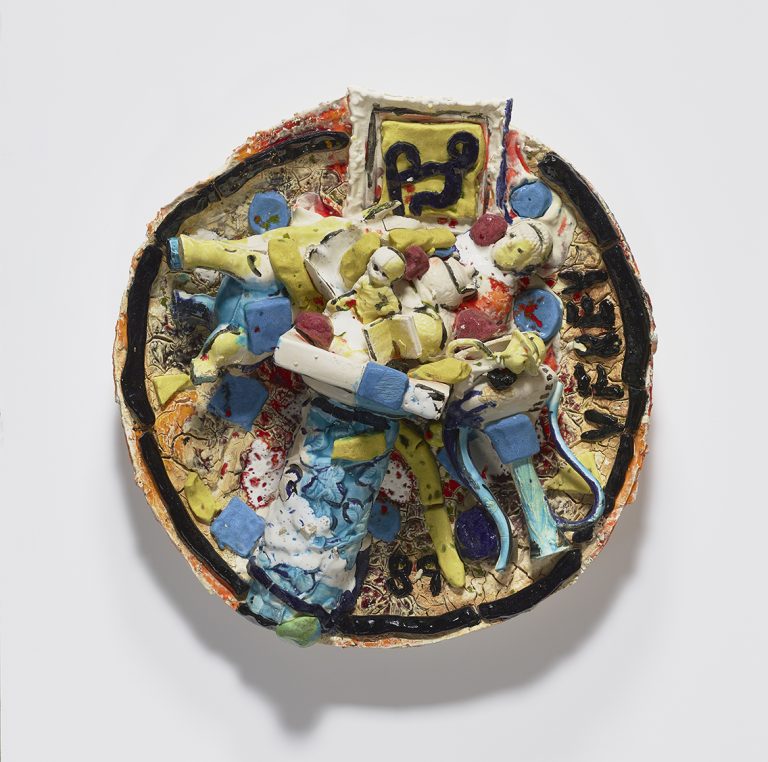
Viola Frey, Shelf of Figurines, 1989, ceramic, glazes, and Egyptian paste, 25 x 25 x 10 1/2 inches (63.5 x 63.5 x 26.7 cm), VF-0154P
1989
The Loma Prieta earthquake causes significant destruction around the Bay Area, and Frey’s studio sustains structural damage. Frey sees a bronze sculpture “fly across the room” and cause a standing clay figure that was being built to fall. Several early works are damaged, including bricolage sculptures and standing women with thin ankles. Because the suited men are reinforced, they are mostly spared.
1990
Frey presents her work in La Céramique contemporaine aux États-Unis, Musée d’Art Moderne de la Ville de Paris. She spends one month in Sèvres painting several sculptures for her Western Civilization series.
1991
To celebrate the opening of the Shigaraki Ceramic Cultural Park, Shigaraki, Japan, Frey is invited to create World Man and World Woman (both 1991). The standing figures are constructed and fired ahead of time in her Oakland studio, then shipped as separate components to Japan. She finishes them there in a glaze painting demonstration.
Frey is invited to design a screenprinted wallpaper to be produced at the Fabric Workshop, Philadelphia. The final wallpaper and borders include forty different screenprints.
1992
Frey’s largest sculpture, Decline and Fall of Western Civilization (1992), is installed at San Francisco’s Esprit Park. The sculpture includes previously discarded elements from other works as well as additional components and figures. Measuring nearly twenty feet wide and eight feet tall, it is Frey’s most ambitious sculpture to date. When asked about her motivation, she notes that the work “had more impact than any painting hoped to achieve.”
Frey is an artist-in-residence at Pilchuck Glass School, Stanwood, Washington. Frey creates her first painted glass sculptures, as well as a series of glass-etched prints.
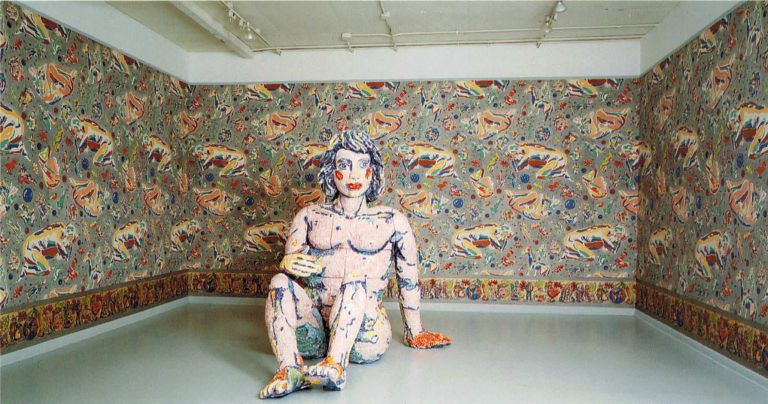
Exhibition view of Viola Frey: Artist’s Mind/Studio/World Wallpaper and Pink Lady, The Fabric Workshop, Philadelphia, PA, 1992

Viola Frey, A World of Possibilities, 1993-1995, ceramic and glazes, largest 168 x inches (426.7 x cm), VF-1077CLS
1993
Frey participates in a five-week artist’s residency at Europees Keramisch Werkcentrum in ‘s-Hertogenbosch, the Netherlands. While there, she collaborates with Betty Woodman on several sculptures.
Frey begins an ambitious two-year commission for a public space in Des Moines—World of Possibilities (1993–95)—a project that limits her other activities and commitments. In a departure from her usual deeply intuitive process, she spends considerable time planning the site-specific sculpture. The female and male figures stand approximately ten feet high, while the globe-topped column, painted frieze-style, is fourteen feet high.
1994
Nancy Hoffman Gallery organizes a traveling exhibition including sixty-three of Frey’s plates. The essay in the accompanying catalogue states: “Again and again Frey creates a sense of indeterminate, oceanic space within the confines of the plate, confirming the sense of looking into another world—the indefinite, fluid, indeed, metamorphic world of memory. She puts abstract expressionist space—modernist decorative space—to remarkable metaphoric use.”
1996-97
Frey moves her studio to a 14,000-square-foot warehouse on Adeline Street in Oakland. The new building allows her the space she needs to make the increasing public art commissions, including the necessary kiln capacity. She makes amphoras enlarged to monumental scale, numerous wall tile paintings, and figures interacting with globes and vessels.
Frey begins her final project for the San Francisco Arts Commission (SFAC, formerly Arts Commission of San Francisco), a wall tile painting for the San Francisco International Airport. Installed in 1999, World Civilization(1999) measures fifteen feet high by twenty feet wide.
1998
Rena Bransten Gallery organizes a presentation of Frey’s early works that includes pieces featured in her 1981 retrospective along with works from the same period that had never before been exhibited. The essay in the accompanying exhibition catalogue begins: “A syncretist of different styles and media, Viola Frey manifests her complex vision in a dizzying conflux of media, references, and content, ranging from the primitive to the classical to the kitsch. She is at once the amalgamator and the innovator, an artist who has dared to experiment with an ultimately refine techniques and iconography that are decidedly and distinctively her own.”
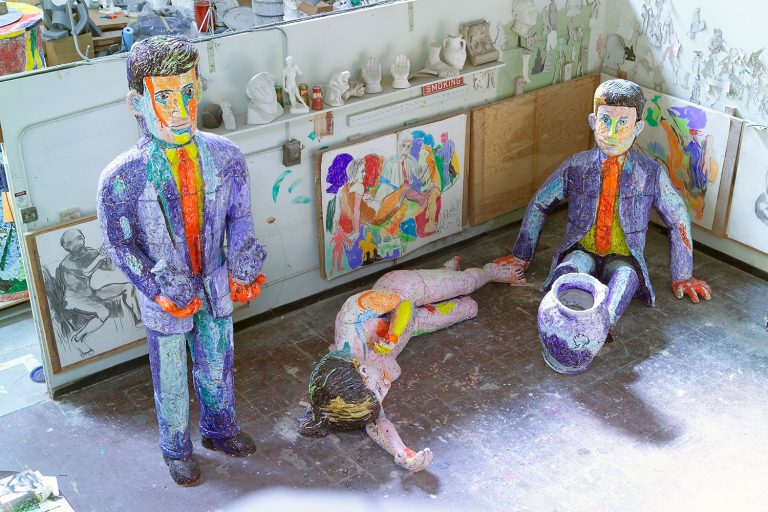
View of Viola Frey’s studio at Adeline Street, Oakland, CA, 2004. Photo: Chris Watson
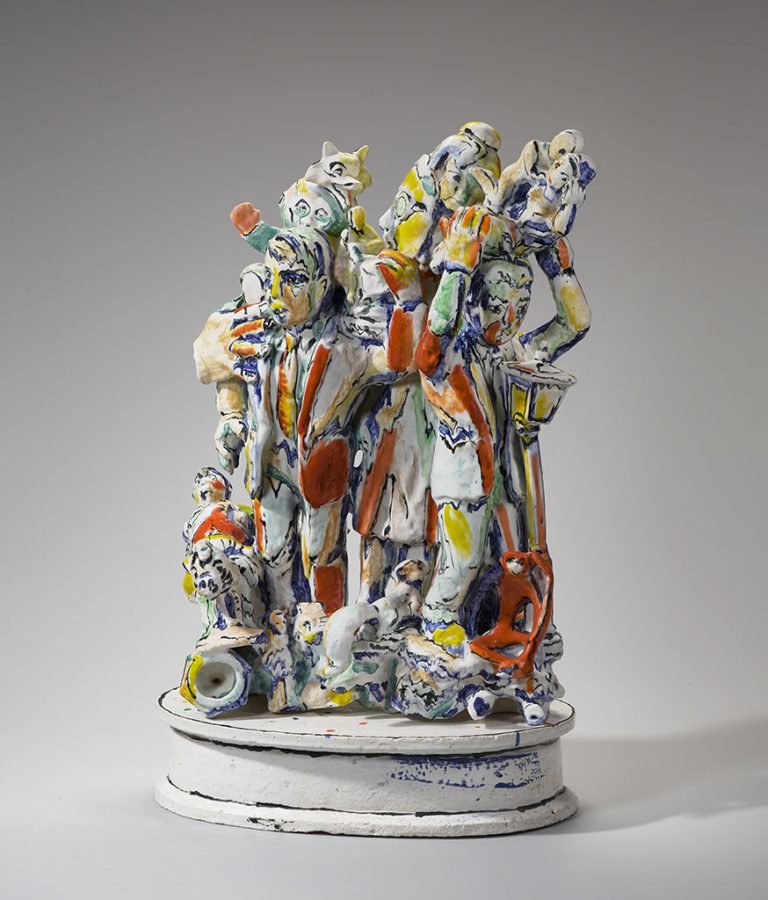
Viola Frey, Western Civilization Series I, 2000, ceramic and glazes, 36 x 23 x 14 inches (91.4 x 58.4 x 35.6 cm), VF-0109CSS
1999
Frey retires from CCAC and becomes professor emerita in ceramics. Later in the year, she receives a Founder’s Day Award.
2000
Frey co-founds the Artists’ Legacy Foundation with Squeak Carnwath and Gary Knecht.
Frey receives an Honorary Doctorate of Fine Art from CCAC for “her impassioned commitment to CCAC students and her inspirational drive to nurture their creative spirits.”
2001
CCAC establishes the Viola Frey Distinguished Visiting Professor Award to “honor the extraordinary life and work of multidisciplinary artist, [CCA] alumna, faculty, and chair of the Ceramics Program, Viola Frey. . . . The award brings prominent artists from around the work to engage with the community and public in critical conversations through lectures, studio visits, and course offerings.”
2002
Frey receives the Masters of the Medium award for Ceramics, presented by the James Renwick Alliance, which honors artists for their excellence.
2003–4
Despite her declining health in recent years, Frey continues her work in the studio with renewed focus. The resulting pieces are presented at Nancy Hoffman Gallery in 2005 as part of Viola Frey: A Lasting Legacy. Hoffman notes of the show, “She had always, always wanted to have a show of white figures, because [she] loved the figures when they were white . . . and she left [a woman, a man and an urn] white by choice.”
On July 26, 2004, Frey dies in her Oakland home surrounded by close friends.
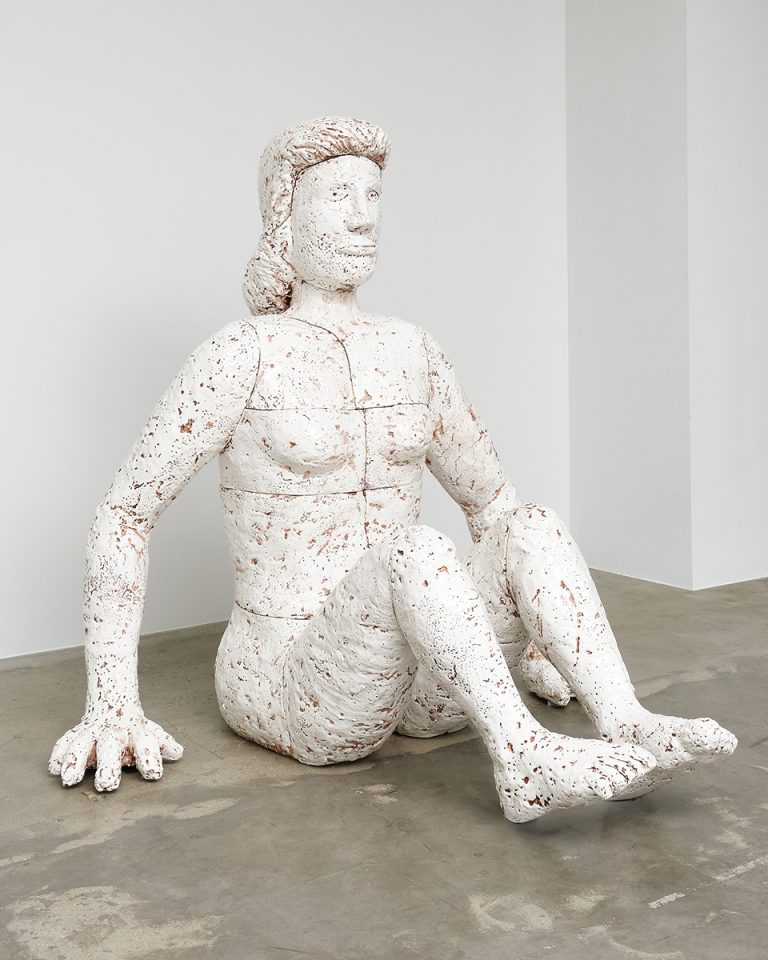
Viola Frey, Seated White Majestic Woman, 2004, ceramic and glazes, 75 x 74 x 69 inches (190.5 x 188 x 175.3 cm), VF-0011CMS. Photo: Chris Hanke